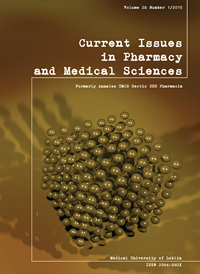Is the vignette method used to assess quality of life in practice?
DOI:
https://doi.org/10.1515/cipms-2015-0032Keywords:
quality of life, vignette, questionnaire, direct interviewAbstract
Purpose. To define how extensive is the use of the vignettes method for quality of life assessment.
Methods. An internet search of different databases was performed to identify and enumerate the publications involving studies in which the vignettes method is employed in relation to quality of life assessment (QoL). PubMed-Medline and Cochrane were scrutinized for publications based on the same search criteria.
Results. Our search found that 6 Cochrane and 105 Medline publications, as well as 28 articles were published between 2011-2014. However, only 7 match the objective of the search.
Conclusion. The rating of vignettes is a promising additional technique to measure changes in QoL and utilities, however, it is not very often employed by the researchers. It can be considered for use as supplementary method to standard QoL measurement methods.
References
1. Au N., Lorgelly P.K.: Anchoring vignettes for health comparisons: an analysis of response consistency. Qual Life Res., 23, 6, 2014. doi: 10.1007/s11136-013-0615-2. [CrossRef] [Web of Science]
2. Betty R. (2011). Reliability and Validity of the Pain Vignettes. Ferrell & Margo McCaffery.
3. Bosch J.L. et al.: Estimating general-population utilities using one binary-gamble question per respondent. Med Decis Making., 18, 4,1998. [CrossRef]
4. Cambell A. (1981). The sense of well-being in America; Recent patterns and trends. New York: McGraw-Hill.
5. Farshad M. et al.: (2011). Determining utility values in patients with anterior cruciate ligament tears using clinical scoring systems. BMC Health Serv Res., 4, 11, 2011. doi: 10.1186/1472-6963-11-182. [Web of Science] [CrossRef]
6. Frederix G.W. et al.: (2013). Utility and work productivity data for economic evaluation of breast cancer therapies in the Netherlands and Sweden. Clin. Ther., 35, 4, 2013:e1-7. doi: 10.1016/j. clinthera.2013.03.009. [CrossRef]
7. Giné-Garriga M. et al.: Referral from primary care to a physical activity programme: establishing long-term adherence? A randomized controlled trial. Rationale and study design. BMC Public Health, 9, 31. 2009. doi:10.1186/1471-2458-9-31. [CrossRef]
8. Kane R. A. (2002) Quality of life. In: Encyclopaedia of Public Health. Vol. 3. New York: Macmillan Reference.
9. Korfage I.J. et al.: Response shift due to diagnosis and primary treatment of localized prostate cancer: a then-test and a vignette study. Qual Life Res., 16, 10, 2007. [CrossRef] [Web of Science]
10. Laventhal N. et al.: Ethics of resuscitation at different stages of life: a survey of perinatal physicians. Pediatrics. 127, 5, 2011 doi: 10.1542/ peds.2010-1031. [Web of Science] [CrossRef]
11. Nordenfelt L. (1993). Quality of life, heath and happiness. Aldershot: Avebury
12. Osborne R.H. et al.: Health-related quality of life advantage of long-acting injectable antipsychotic treatment for schizophrenia: a time trade-off study. Health Qual Life Outcomes, 35, 10, 2012. doi:10.1186/1477-7525-10-35.[CrossRef]
13. Quartin A.A. et al.: Influence of critical illness on physicians’ prognoses for underlying disease: a randomized study using simulated cases.; Critical care medicine, 36, 2, 2008.
14. Racine E. et al.: Profiles of Neurological Outcome Prediction Among Intensivists; Neurocrit Care, 11,3, 2009. doi:10.1007/ s12028-009-9225-9. [Web of Science] [CrossRef]
15. Raeburn J.M., RootmanI. (1996). Quality of life and health promotion. In Renwick R., Brown I., Nagler M. (Ed.): Quality of Life in Health Promotion and Rehabilitation. Conceptual approaches, issues, and applications. Thousand Oaks, CA: Sage.
16. Rossetto A., Jorm A.F., Reavley N.J.: Quality of helping behaviors of members of the public towards a person with a mental illness: a descriptive analysis of data from an Australian national survey. Annals of General Psychiatry, 13, 1, 2014. doi: 10.1186/1744-859X-13-2. [Web of Science] [CrossRef]
17. Schnelle J.F. et al.: A controlled trial of an intervention to increase resident choice in long term care. Journal of the American Medical Directors Association, 14, 5, 2013. [CrossRef]
18. Schwartz C.E. et al.: The clinical significance of adaptation to changing health: A meta-analysis of response shift. Quality of Life Research 15,9, 2006. doi: 10.1007/s11136-006-0025-9. [CrossRef]
19. Sheldricket C.R. et al.: Variations in Physician Attitudes Regarding ADHD and Their Association With Prescribing Practices. Journal of Attention Disorders 9, 11, 2012.
20. Shingler S.L. et al. Elicitation of health state utilities in soft tissue sarcoma. Quality of Life Research 22, 7, 2013. doi: 10.1007/ s11136-012-0301-9. [Web of Science] [CrossRef]
21. Swinburn P. et al.: Elicitation of health state utilities in neuroendocrine tumours. J Med Econ.15, 4, 2012. doi: 10.3111/13696998.2012.670175. [CrossRef]
22. Xie F., Oremus M., Gaebel K.: Measuring health-related quality-oflife for Alzheimer’s disease using the general public. Quality of Life Research, 21, 4, 2012.
Downloads
Published
Issue
Section
License
Copyright (c) 2015 Authors

This work is licensed under a Creative Commons Attribution-NonCommercial-NoDerivatives 3.0 Unported License.


